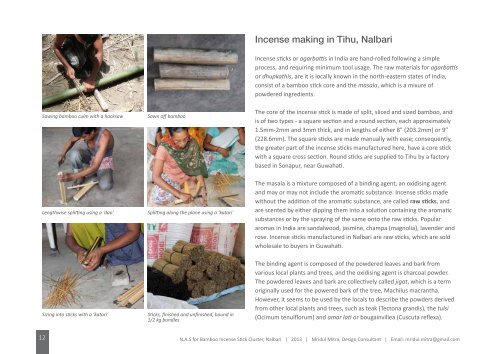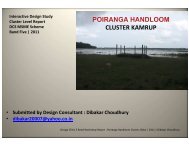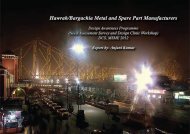Bamboo Incense Stick Cluster, Nalbari - Design Clinic Scheme
Bamboo Incense Stick Cluster, Nalbari - Design Clinic Scheme
Bamboo Incense Stick Cluster, Nalbari - Design Clinic Scheme
You also want an ePaper? Increase the reach of your titles
YUMPU automatically turns print PDFs into web optimized ePapers that Google loves.
<strong>Incense</strong> making in Tihu, <strong>Nalbari</strong><br />
<strong>Incense</strong> sticks or agarbattis in India are hand-rolled following a simple<br />
process, and requiring minimum tool usage. The raw materials for agarbattis<br />
or dhupkathis, are it is locally known in the north-eastern states of India,<br />
consist of a bamboo stick core and the masala, which is a mixure of<br />
powdered ingredients.<br />
Sawing bamboo culm with a hacksaw<br />
Sawn off bamboo<br />
The core of the incense stick is made of split, sliced and sized bamboo, and<br />
is of two types - a square section and a round section, each approximately<br />
1.5mm-2mm and 3mm thick, and in lengths of either 8” (203.2mm) or 9”<br />
(228.6mm). The square sticks are made manually with ease; consequently,<br />
the greater part of the incense sticks manufactured here, have a core stick<br />
with a square cross section. Round sticks are supplied to Tihu by a factory<br />
based in Sonapur, near Guwahati.<br />
Lengthwise splitting using a ‘dao’<br />
Splitting along the plane using a ‘katari’<br />
The masala is a mixture composed of a binding agent, an oxidising agent<br />
and may or may not include the aromatic substance. <strong>Incense</strong> sticks made<br />
without the addition of the aromatic substance, are called raw sticks, and<br />
are scented by either dipping them into a solution containing the aromatic<br />
substances or by the spraying of the same onto the raw sticks. Popular<br />
aromas in India are sandalwood, jasmine, champa (magnolia), lavender and<br />
rose. <strong>Incense</strong> sticks manufactured in <strong>Nalbari</strong> are raw sticks, which are sold<br />
wholesale to buyers in Guwahati.<br />
Sizing into sticks with a ‘katari’<br />
<strong>Stick</strong>s, finished and unfinished, bound in<br />
1/2 kg bundles<br />
The binding agent is composed of the powdered leaves and bark from<br />
various local plants and trees, and the oxidising agent is charcoal powder.<br />
The powdered leaves and bark are collectively called jigat, which is a term<br />
originally used for the powered bark of the tree, Machilus macrantha.<br />
However, it seems to be used by the locals to describe the powders derived<br />
from other local plants and trees, such as teak (Tectona grandis), the tulsi<br />
(Ocimum tenuiflorum) and amar lati or bougainvillea (Cuscuta reflexa).<br />
12<br />
N.A.S for <strong>Bamboo</strong> <strong>Incense</strong> <strong>Stick</strong> <strong>Cluster</strong>, <strong>Nalbari</strong> | 2013 | Mridul Mitra, <strong>Design</strong> Consultant | Email: mridul.mitra@gmail.com







